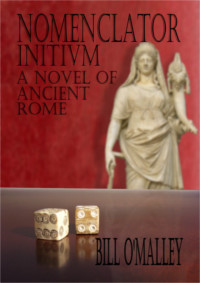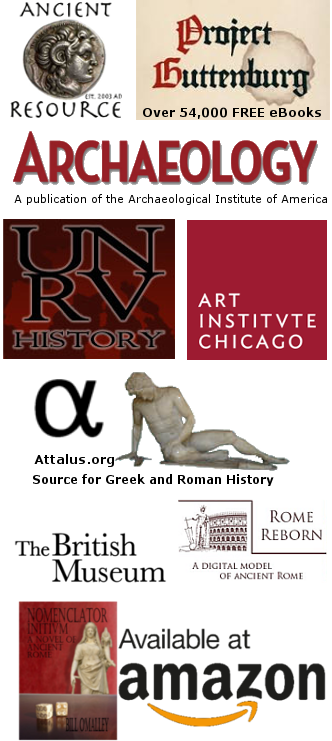


Fun and Interesting Facts About Ancient Rome.
Some ancient Romans used phallic symbols as good luck charms.1
- The abbreviation SPQR is found on many Roman buildings, statues, and in political literature. It is an acronym for: Senatus Populusque Romanus, meaning, "The Senate and People of Rome."1
Rome's ancient population of more than one million went unmatched by any other European city until London reached that mark in the 19th century.4
The English word, "decimate," meaning to destroy, comes from the Latin word, decimare, which refers to the practice of killing every tenth Roman soldier in a legion as a punishment for mutiny.1
In ancient Rome, the only women who wore togas were prostitutes.9
Sometimes gladiator's blood was prescribed by physicians to treat infertility.9
After the Spartucus slave rebellion was supressed, 6000 captured slaves were crucified and left to rot along the Appian Way from Rome to Capua.9
The punishment for a Vestal Virgin who lost her virginity, even if raped, was to be entombed alive.5
Cato the Elder recommended putting goat dung in the diaper of a sleepless baby to settle the child.4
The Circus Maximus could seat over 250,000 spectators.2
Wealthy Roman women used a cosmetic made from lead paste to make their skin appear paler.8
Roman days and nights were divided into twelve hours each, so in the summer, daytime hours were longer and nighttime hours were shorter. The opposite occured in the winter.2
It was regarded as ill-omened if both oxen in a team defecated simultaneously while yoked.3
Cato the Elder believed that most unrest among slaves was caused by sexual frustration, so he allowed his male slaves to have intercourse with his female slaves - for a fixed price, payable to him.7
Some ancient Romans used phallic symbols as good luck charms.1
Rome's ancient population of more than one million went unmatched by any other European city until London reached that mark in the 19th century.4
The English word, "decimate," meaning to destroy, comes from the Latin word, decimare, which refers to the practice of killing every tenth Roman soldier in a legion as a punishment for mutiny.1
In ancient Rome, the only women who wore togas were prostitutes.9
Sometimes gladiator's blood was prescribed by physicians to treat infertility.9
After the Spartucus slave rebellion was supressed, 6000 captured slaves were crucified and left to rot along the Appian Way from Rome to Capua.9
The punishment for a Vestal Virgin who lost her virginity, even if raped, was to be entombed alive.5
Cato the Elder recommended putting goat dung in the diaper of a sleepless baby to settle the child.4
The Circus Maximus could seat over 250,000 spectators.2
Wealthy Roman women used a cosmetic made from lead paste to make their skin appear paler.8
Roman days and nights were divided into twelve hours each, so in the summer, daytime hours were longer and nighttime hours were shorter. The opposite occured in the winter.2
It was regarded as ill-omened if both oxen in a team defecated simultaneously while yoked.3
Cato the Elder believed that most unrest among slaves was caused by sexual frustration, so he allowed his male slaves to have intercourse with his female slaves - for a fixed price, payable to him.7
References
1 Burgan, Michael. 2005. Empire of Ancient Rome. New York, NY: Facts on File Books.
2 Casson, Lionel. 1998. Everyday in Ancient Rome. Baltimore, MD: The John Hopkins University Press.
3 Cicero, On Divination 2.77
4 Constable, Nick. 2003. Historical Atlas of Ancient Rome. New York, NY: Thalamus Publishing.
5 Cowell, F. R. 1976. Life in Ancient Rome. New York, NY: The Berkeley Publishing Group.
6 McKeown, J. C. 2010. A Cabinet of Roman Curiosities. Oxford, UK: Oxford University Press.
7 Nardo, Don. 2003. Women of Ancient Rome. Farmington Hills, MI: Lucent Books.
8 Plutarch, Life of the elder Cato.
9 Wolf, Greg, ed. 2003. Cambridge Illustrated History: Roman World. Cambridge, UK: Cambridge University Press.
These links are being provided as a convenience and for informational purposes only; they do not constitute an endorsement or an approval by Nomenclator Books or Bill O'Malley of any of the products, services or opinions of the corporation or organization or individual. Nomenclator Books and Bill O'Malley bears no responsibility for the accuracy, legality or content of the external site or for that of subsequent links. Contact the external site for answers to questions regarding its content.









